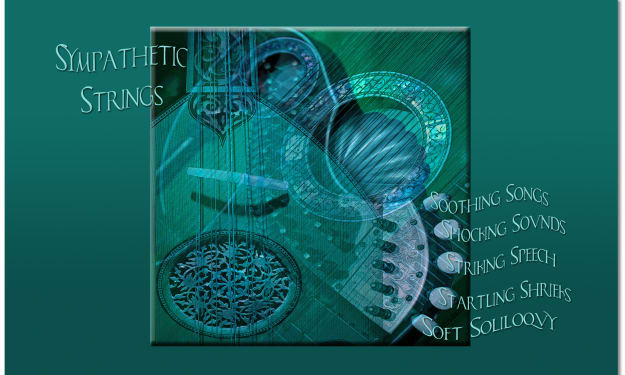
VOICELESS UNIVERSE:
A TALE OF PARA THE EXPLORER
BY IRIS BROOKS
CHAPTER ONE: LOST IN SPACE
Nobody can hear a scream in the vacuum of space, or so they say. Plants and trees can “hear” sounds through vibrations in their leaves. And humans also respond to the impact of vibrations. Likewise, 24th-century humans have evolved in voiceless worlds to both “hear” and communicate with organs other than the ears or mouth.
Sound is an all-encompassing experiential phenomenon, no longer relegated to waves transmitting music or language by speaking and hearing, as it was in the ancient world. When 24th-century Para the Explorer is lost in space, her mind races through philosophical questions about sound, as her destiny remains unclear. If a tree falls in a forest and no one is around to hear it, does it make a sound? This question was pondered as far back as the 1600s, and for Para, the answer is a resounding yes.
Para lets out a series of high-decibel, vibration field-filled screams (sans sound) permeated with her multi-colored energy. Her body and mind float through the universe as she recalls a 21st-century musician without the ability to hear, who became a virtuosic percussionist by “listening” through her feet. Para thrusts her voiceless screams out of her entire body, piercing through and beyond her protective, life-supporting suit.
When she was a student at the Space Academy, Para showed great promise in her advanced vibrational skills, telepathic abilities, and diplomatic tact. Could this assist her now at a crucial moment, to reposition her course without functioning navigational tools in a foreboding galaxy punctuated by flying asteroids, unpredictable weather patterns, and an unstable atmosphere?
Para is practical and philosophical, even under great stress, as she gauges how far her vibro-screams can carry. While employing a prismatic spectrum of vibrations, she welcomes a reply–in any color–from a nearby species, re-directing her on a course to complete her mission. She focuses like a laser beam on her inter-planetary S.O.S. call to friendly life forms in known and unknown worlds, while imagining a first-contact savior. After all, at the Academy she was taught intent, stemming from imagination, is a key facet in actualizing one’s reality.
Her employer is the well-respected, Intergalactic Agency For Peaceful Worlds. They selected her for this research and development mission because of her excellent paranormal skills and investigative rigor. But her independent spirit–which has served her well in the past–has left her alone.
When an almost imperceptible, dim, blinking light appears in the distance, she wonders if she is really flying solo . . . Not sure if the glow is a hallucination, a star, or an alien vessel, Para remains optimistic.
The light is a momentary distraction, which both fuels her innovative thinking and stirs up memories reflective of a more sedate life on Earth. Flickering strings of lights on her backyard pavilion welcomed her home after a long day at the Intergalactic Agency, planning strategies for bringing together dignitaries from planets with disparate agendas. Lights also brightened planetary maps of the ever-shrinking, known world.
Para feels a yearning for her lost starship, lit up like a sparkling jewel. Her heartbeat quickens as she conjures up images of the inspirational Luminary, adorned with a colorful rainbow painted on the resilient, titanium exterior. The Luminary has been home base for many years, serving as her guiding light (both literally and figuratively) during off-and-on again explorations, where she has successfully brought together divergent, and sometimes incompatible species in both intimate and monumental gatherings with the aid of advanced vibration communications as well as intergalactic music resonating in many worlds.
She fondly recalls how she bridged a dispute with sophisticated telepathic and audio communications between plant life and humanoids through a successful intervention on Europa, the largest moon of Jupiter. And on a series of voyages to the moon–long thought of as a cultural mirror for many–where rituals for the locals involve playing music to welcome in new life and complete the life cycle at death, she interceded, calling upon sonic duets in conjunction with collective artwork to mediate and resolve their differences. But at the moment, these diplomatic missions are part of a very distant past.
She drifts through space slowly in a dreamy, meditative state with her eyes closed. As she relaxes, quieting her being, she listens. After all, her mission is to delve into the philosophical concept of the “music of the spheres” from different locales, absorbing contrasting perspectives and gaining a new understanding of its powerful song, while determining how to implement these sonic solutions into protocol for diplomatic conventions among distinct and diverse species.
Para had studied ancient texts about Pythagoras (dubbed “The Father of Music”) and the Greek master Aristotle, along with their theories, as well as Kepler, a German astronomer, who believed a celestial chord resulted in a continuous and ever-changing song. While it was known celestial bodies produced music expressing and modulating emotion as well as enhancing the brain, it was her job to investigate swirling threads of more esoteric and long-held mystical ideas, transforming them into a tangible pathway. If music could rewire the circuitry of our brains, she felt it was reasonable to assume sounds from the “music of the spheres” could achieve much more in an ever-evolving universe. But this project was temporarily on hold, or at least until she was safely back on course.
It is hard to fathom a mechanical mishap could have thrust her out, separating her from her reliable ship. In this instant Para’s world turns upside down as the unknown stretches out before her. Usually the uncharted and mysterious draw her in, but this time the uncertainty leaves her pining for something familiar, like tasty culinary specialties: soothing vichyssoise from Venus adorned with freshly-cut chives (thankfully Venus is now a habitable planet through its transition by terraforming) or refreshing Martian mango and melon mélange on the red planet with pink skies and blue-tinged sunsets. She pushes aside thoughts of flavorful delicacies in an array of hues as her mind shifts back to the light.
Para speculates on the source of this bewildering, flickering, and possibly enlightening aura from afar. Perhaps it is a beacon acting as a signal or a searchlight looking for her, fixing on her position? While its purpose and origin are unknown, her breath slows as the fear begins to dissipate and without screaming, a new adventure unfolds. The glow of the iridescent illumination beckons, instilling her with hope.
END Of CHAPTER ONE
About The Author:
Iris Brooks is an experienced writer with hundreds of published travel and culture stories based on her journeys through all of the continents. While she has not participated in space travel, she welcomes the opportunity to take flight to new worlds. You may view more of her work along with collaborator, Jon H. Davis at the Northern Lights Studio website, www.NLScreativemedia.com
About the Creator
Iris Brooks
Iris Brooks has hundreds of published travel and culture stories based on journeys to all of the continents. She is attracted to Japanese aesthetics including haikus. See more at the NLS website, www.NLScreativemedia.com






Comments (1)
A most interesting predicament in space. I can only wonder what happens next to Para The Explorer.